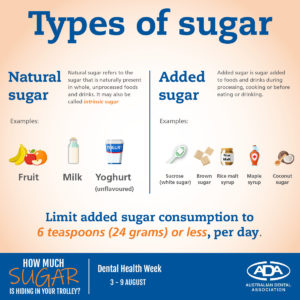How Much Sugar is Hiding in Your Trolley?
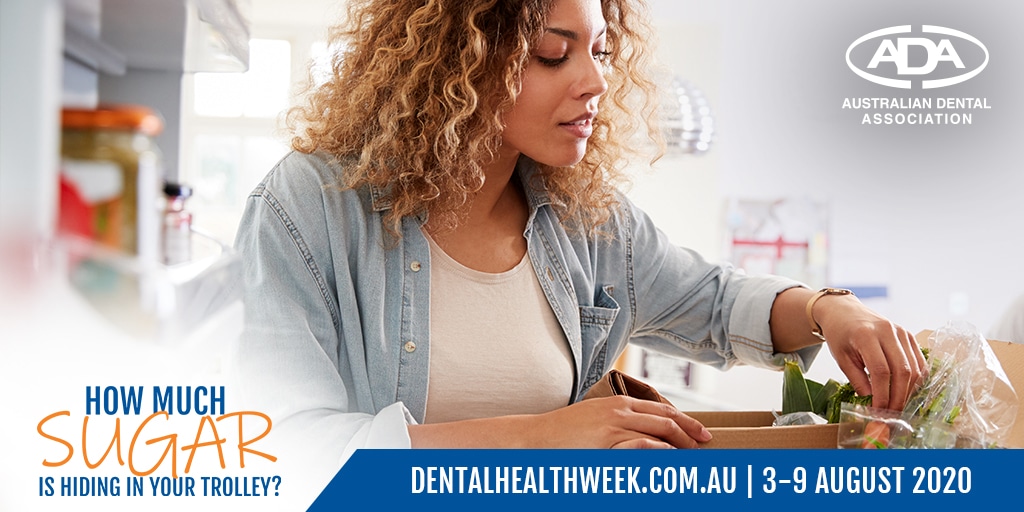
Do you know how much sugar is really hiding in your trolley? Sugar is everywhere in supermarket staples, even some that might appear to be healthy on the surface, and so this Dental Health Week (3 – 9 August), we’re pulling back the sugary curtain to show you what’s really in the food you eat, and how this information can help you make healthier choices, for your overall health but especially your oral health.
Here are some facts that may surprise you!
- The average Australian is consuming 14 teaspoons of sugar a day, a whole lot more than the maximum 6 teaspoons (24 grams) a day
- Did you know that a glass of juice and bowl of cereal for breakfast can equal 6 or more teaspoons of sugar?
- There are 16 teaspoons of sugar in one 600ml can of soft drink
- Did you know if you drink fruit juice, the recommended serving size is 125ml of 100% fruit juice?
Understanding Sugar
- Sugar can be called over 50 different names, making it hard to detect on food and drink labels. These are known as hidden sugars.
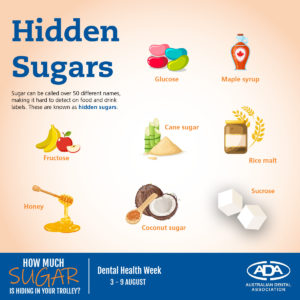
Look out for these names on the ingredient list of nutrition information panels when shopping. Even foods and drinks which claim to have no added or refined sugars, can contain a lot of sugar. The closer the ingredient is to the top of the ingredient list, the more of it present in the food or drink.
- Products that claim ‘no added sugar’ can still contain a LOT of sugar.
- Natural sugar refers to the sugar that is naturally present in whole, unprocessed foods and drinks, such as fruit, milk and unflavoured yoghurt.
- Added sugar is sugar added to foods and drinks during processing, cooking or before eating or drinking, such as sucrose (white sugar), brown sugar, rice malt syrup, maple syrup and coconut sugar.
Fruit and milk are made up of small amounts of natural sugars as well as fibre, vitamins and minerals which are good for the body. Milk also includes calcium, which can help to protect the teeth and bones. Processed foods with large quantities of added sugar often have no or limited nutritional value.
Sugar Maths and Food Labels
- Most food labels don’t point out the added sugars. When you look at the list of ingredients, the nearer the ingredient is to the top of the list, the more present in the food or drink.
- If sugar is near the top of the list, this indicates there is more sugar present in the product, over and above the other ingredients. In some products, sugar is at the top of the list of ingredients.
- Look at the value for sugar per 100 grams (this helps compare ‘apples with apples’ when comparing with other products). If the number is greater than 15 grams, consider finding an alternative with a lower sugar content.
- Ideally look for foods and drinks with less than 5 grams per 100 grams of sugar, but less than 10 grams is acceptable.
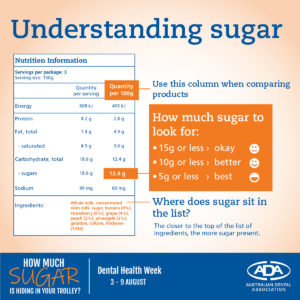
Getting the Balance Right
- It’s no secret that sugar consumption can lead to tooth decay. Try and consume no more than 6 teaspoons/24 grams of sugar per day.
- Brush your teeth twice a day using fluoride toothpaste
- Clean between your teeth once a day with floss or interdental brushes
- See your dentist regularly for a clean and check up. Ask our staff about how you can score yourself a movie voucher just for seeing your dentist!
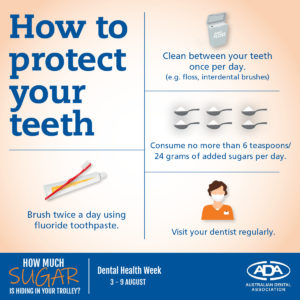
Maintaining good oral health is super important during your orthodontic treatment if you want to achieve the best results. Read more here about why it’s so important, and what you can do to ensure you keep those pearly whites as healthy as possible!
Take our ‘Get Sugar Savvy’ quiz and go into the running to win a $100 Visa prepaid voucher! Winner drawn 31st August, winner announced shortly after 🙂 [Comp now closed]
Until next time,
Keep Smiling!


